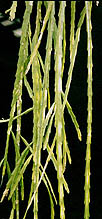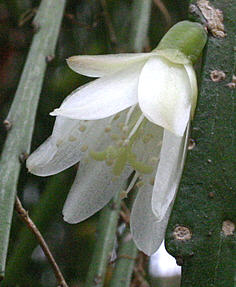|
Lepismium
warmingianum ( K
Schumann) Barthlott in Bradleya 5
Left to right: 2nd and 3rd from left) R. gonocarpa R. warmingiana from Britton & Rose; (photo far right) R. linearis taken at Huntington Botanical Garden, 9/99 KAF Desc from B&R 1923 Plant-
at first erect, then spreading or hanging; branches elongated, jointed,
10 mm. wide or less, either flat or sharply 3 or 4-angled,
more or less blotched or colored throughout with purple or red;
Type locality: Near Lagoa Santa, Minas Geraes; two localities were cited when first described, this being the first.. The plant has long been in cultivation, where it does well and blooms freely. Dr. Rose brought back a fresh supply from Brazil in 1915. According to Robert Lamb, the flowers have a perfume resembling that of a hyacinth. DISTRIBUTION. Brazil (Minas Gerais, Espirito Santo, Rio de Janeiro, Sao Paulo, Mato Grosso do Sul, Parana, Santa Catarina, Rio Grande do Sul), eastern Paraguay, Argentina (Misiones): epiphyte in seasonal forest, to 1100 m altitude. Note from Bradleya 13 The lectotype is an unusually broad-stemmed form of the species and without knowledge of its provenance could easily be confused with the sister species, L. lorentzianum. The supposedly white-fruited Rhipsalis linearis K. Schumann (l.c., Balansa 2500, K!, ) is treated as a synonym, since material so-named exhibits no obvious and reliable vegetative or floral differences. White fruits have not otherwise been seen in this species and raise suspicions that they were described in error or represented some sort of rare mutation. Desc
from Hunt 2006. Rhipsalis warmingiana K.
Sch.
Habitat Brazil (Minas Geraes ; Sao Paulo).
|



